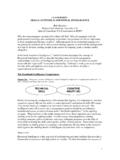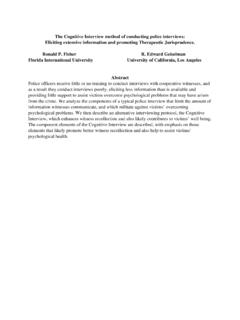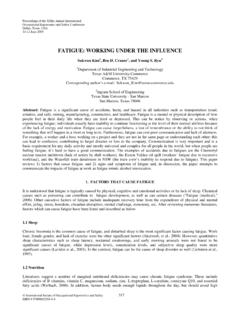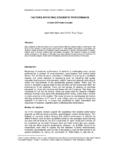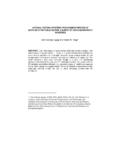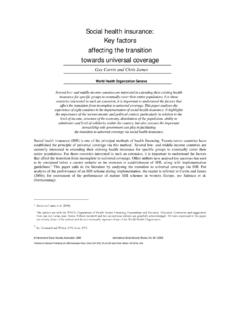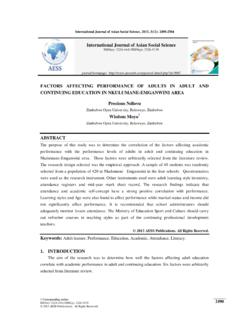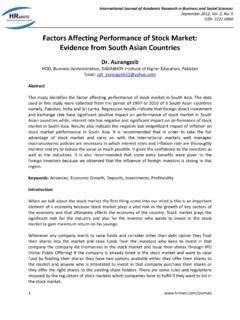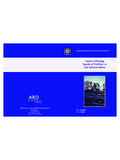Transcription of Factors Affecting Reaction Time
1 Factors Affecting Reaction time Scientific Journal Reviews Reviewing journal articles can be a daunting task because of the length and complexity of the research conducted. I have conducted a review of Reaction time articles and summarized the results into categories. References are listed with each category and can be reviewed in depth at the end under bibliography. You can use this information to better understand and predict performance under a variety of conditions and situations. Mean Reaction Times 1. For about 120 years, the accepted figures for mean simple Reaction times for college- age individuals have been about 190 ms ( sec) for light stimuli and about 160 ms ( ) for sound stimuli (Galton, 1899; Fieandt et al.)
2 , 1956; Welford, 1980; Brebner and Welford, 1980). Simple vs. Complex Responses & Reaction Times 1. More complex responses also elicit slower Reaction times. Henry and Rogers (1960). proposed the "memory drum" theory: that more complex responses require more stored information, and hence take longer. The status of this theory was reviewed by Klapp (2010). Number of Possible Valid Stimuli. 1. Several investigators have looked at the effect of increasing the number of possible stimuli in recognition and choice experiments. Hick (1952) found that in choice Reaction time experiments, response was proportional to log(N), where N is the number of different possible stimuli. In other words, Reaction time rises with N, but once N gets large, Reaction time no longer increases so much as when N was small.
3 This relationship is called "Hick's Law.". 2. Sternberg (1969) maintained that in recognition experiments, as the number of items in the memory set increases, the Reaction time rises proportionately (that is, proportional to N, not to log N). Reaction times ranged from 420 msec for 1 valid stimulus (such as one letter in symbol recognition) to 630 msec for 6 valid stimuli, increasing by about 40. Page 1. California Training Institute, 1831 Quail Court, St. Helena, CA 94574. (707)9685109. msec every time another item was added to the memory set. Nickerson (1972) reviewed several recognition studies and agreed with these results. Type of Stimulus 1. Many researchers have confirmed that Reaction to sound is faster than Reaction to light, with mean auditory Reaction times being 140-160 msec and visual Reaction times being 180-200 msec (Galton, 1899; Woodworth and Schlosberg, 1954; Fieandt et al.)
4 , 1956;. Welford, 1980; Brebner and Welford, 1980). Perhaps this is because an auditory stimulus only takes 8-10 msec to reach the brain (Kemp et al., 1973), but a visual stimulus takes 20-40 msec (Marshall et al., 1943). 2. Reaction time to touch is intermediate, at 155 msec (Robinson, 1934). Differences in Reaction time between these types of stimuli persist whether the subject is asked to make a simple response or a complex response (Sanders, 1998, p. 114). Stimulus Intensity 1. Froeberg (1907) found that visual stimuli that are longer in duration elicit faster Reaction times, and Wells (1913) got the same result for auditory stimuli. 2. Pi ron (1920) and Luce (1986) reported that the weaker the stimulus (such as a very faint light) is, the longer the Reaction time is.
5 However, after the stimulus gets to a certain strength, Reaction time becomes constant. In other words, the relationship is: Arousal 1. One of the most investigated Factors Affecting Reaction time is 'arousal' or state of attention, including muscular tension. Reaction time is fastest with an intermediate level of arousal, and deteriorates when the subject is either too relaxed or too tense Page 2. California Training Institute, 1831 Quail Court, St. Helena, CA 94574. (707)9685109. (Welford, 1980; Broadbent, 1971; Freeman, 1933). That is, Reaction time responds to arousal as follows: 2. while some subjects showed the traditional pattern in the graph above, others showed the opposite trend. In general, Reaction time tended to improve as arousal increased.
6 Martinie et al. (2010) found that being forced to write an essay defending opinions that the writer Age 1. Simple Reaction time shortens from infancy into the late 20s, then increases slowly until the 50s and 60s, and then lengthens faster as the person gets into his 70s and beyond (Welford, 1977; Jevas and Yan, 2001; Luchies et al., 2002; Rose et al., 2002; Der and Deary, 2006). 2. Luchies et al.(2002) also reported that this age effect was more marked for complex Reaction time tasks, and Der and Deary (2006) concurred. 3. Reaction time also becomes more variable with age (Hultsch et al., 2002; Gorus et al., 2008). 4. MacDonald et al. (2008) found that Reaction time variability in older adults was usually associated with slower Reaction times and worse recognition of stimuli, and suggested that variability might be a useful measure of general neural integrity.
7 5. Welford (1980) speculates on the reason for slowing Reaction time with age. It is not just simple mechanical Factors like the speed of nervous conduction. It may be the tendency of older people to be more careful and monitor their responses more thoroughly (Botwinick, 1966). When troubled by a distraction, older people also tend to devote Page 3. California Training Institute, 1831 Quail Court, St. Helena, CA 94574. (707)9685109. their exclusive attention to one stimulus, and ignore another stimulus, more completely than younger people. 6. Redfern et al., (2002), & Myerson et al. (2007) found that older adults were as adept as younger people at assimilating information, but they did take longer to react.
8 Gender 1. In almost every age group, males have faster Reaction times than females, and female disadvantage is not reduced by practice (Noble et al., 1964; Welford, 1980; Adam et al., 1999; Dane and Erzurumlugoglu, 2003; Der and Deary, 2006). The last study is remarkable because it included over 7400 subjects. Bellis (1933) reported that mean time to press a key in response to a light was 220 msec for males and 260 msec for females; for sound the difference was 190 msec (males) to 200 msec (females). 2. Botwinick and Thompson (1966) found that almost all of the male-female difference was accounted for by the lag between the presentation of the stimulus and the beginning of muscle contraction. Muscle contraction times were the same for males and females.
9 3. Barral and Debu (2004) found that while men were faster than women at aiming at a target, the women were more accurate. 4. Jevas and Yan (2001) reported that age-related deterioration in Reaction time was the same in men and women. Left vs. Right Hand 1. The hemispheres of the cerebrum are specialized for different tasks. The left hemisphere is regarded as the verbal and logical brain, and the right hemisphere is thought to govern creativity, spatial relations, face recognition, and emotions, among other things. Also, the right hemisphere controls the left hand, and the left hemisphere controls the right hand. This has made researchers think that the left hand should be faster at Reaction times involving spatial relationships (such as pointing at a target).
10 2. Boulinquez and Bart l my (2000) and Bart l my and Boulinquez (2001 and 2002) all supported this idea. Dane and Erzurumluoglu (2003) found that in handball players, the left-handed people were faster than right-handed people when the test involved the left hand, but there was no difference between the Reaction times of the right and left handers when using the right hand. Finally, although right-handed male handball players had faster Reaction times than right-handed women, there was no such sexual difference between left-handed men and women. The authors concluded that left- Page 4. California Training Institute, 1831 Quail Court, St. Helena, CA 94574. (707)9685109. handed people have an inherent Reaction time advantage.
